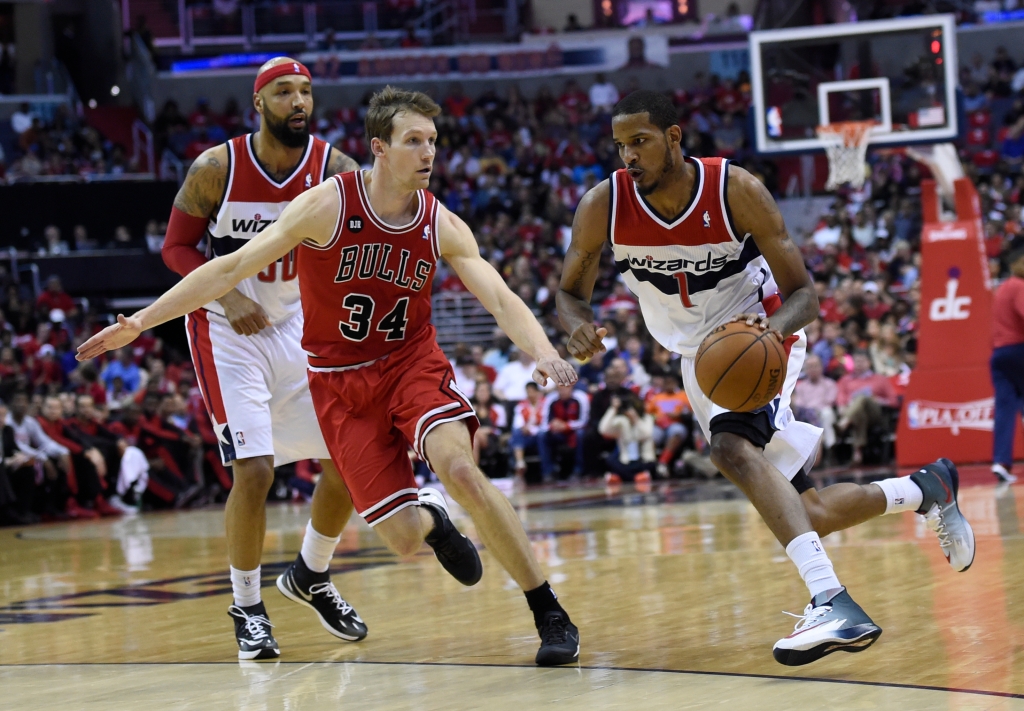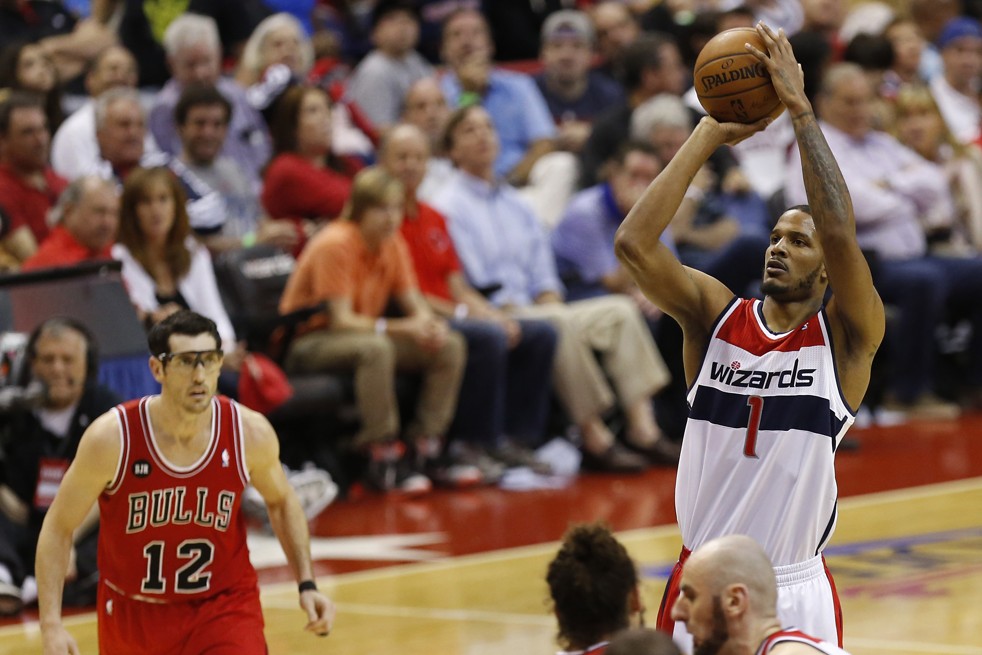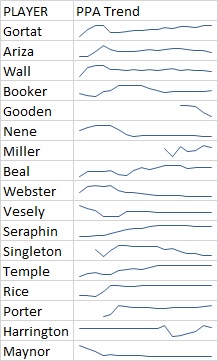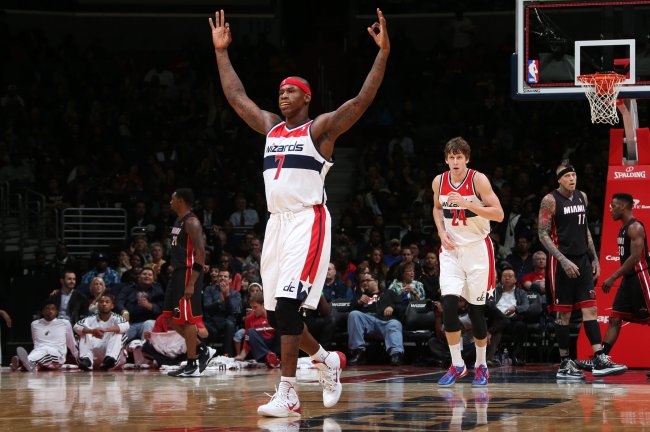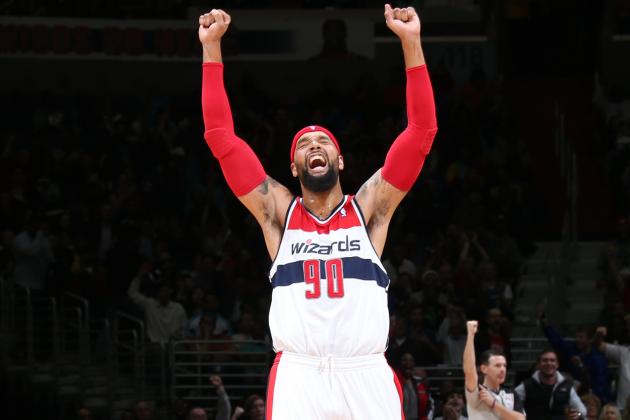Improvement from the Washington Wizards youngsters, and an infusion of frontcourt depth will be offset by missed time due to injuries and declines from the team’s older players to keep the team in the middle of the NBA pack for another year. However, the team could be a dangerous playoffs matchup if they’re able to enter the postseason healthy.
Below, I’m offering up projections done a couple different ways. The first is built on the similarity scores I’ve posted after the past week. This approach finds players in NBA history with similar production at a similar age, and then looks at what they did in subsequent seasons. Those findings are then applied to the Wizards roster and combined with a playing time estimate for each player.
For this estimate (and the other one, which I’ll get to later in this post), I’ve used my overall metric Player Production Average (PPA), which is calibrated to explain individual player contributions to winning and losing. PPA is pace neutral, accounts for defense, and includes a “degree of difficulty” factor based on the level of competition a player faces while on the court. In PPA, 100 = average, higher is better, and 45 = replacement level.
Statistical Doppelganger Projection
| POS | PLAYER | MIN | LAST SEASON PPA | PROJECTED PPA | PROJECTED kWins |
| PG | John Wall | 2812 | 139 | 156 | 9.0 |
| C | Marcin Gortat | 2464 | 154 | 132 | 6.7 |
| SG | Bradley Beal | 2325 | 96 | 112 | 6.1 |
| SF | Paul Pierce | 1800 | 139 | 108 | 4.0 |
| SF | Otto Porter | 1800 | 15 | 85 | 3.2 |
| PF | Kris Humprhies | 1608 | 132 | 133 | 4.4 |
| F/C | DeJuan Blair | 1450 | 97 | 97 | 2.9 |
| PF | Nenê | 1430 | 102 | 90 | 2.7 |
| PG | Andre Miller | 1165 | 86 | 65 | 1.6 |
| G/F | Glen Rice Jr. | 1029 | 20 | 78 | 1.2 |
| F/C | Drew Gooden | 1002 | 106 | 100 | 2.1 |
| G/F | Martell Webster | 1000 | 77 | 74 | 1.5 |
| POS | TEAM | 19885 | 107 | 110 | 45.4 |
MIN = projected TOTAL minutes for the upcoming season
Projected kWins = how many wins that player will contribute based on his projected PPA and projected total minutes.
Over the past few seasons, the Wizards’ front office has converted the team from being one of the league’s youngest to being one of the league’s oldest. Gortat, Nenê, Pierce, Gooden and Miller all figure to play prominent roles this season, and all are past 30. Well past 30 for Pierce and Miller.
Projections for Porter and Rice were difficult because they played so little last season. For both, I elected to throw out their rookie numbers and rely instead on projections based on the rookie seasons of the players they were most like from college. Using the rookie numbers would lower Porter’s projected PPA to 66 and Rice’s to 30. That would drop Washington’s projected win total 43.8.
Note that I didn’t include Kevin Seraphin, Garrett Temple or Rasual Butler in the above table. They’ll get some minutes along the way, but — barring several catastrophic injuries — none should see enough court time to have a major effect on the team’s fortunes. For those interested, this is what I project for the end-of-the-bench trio:
- Garrett Temple: 33
- Kevin Seraphin: 49
- Rasual Butler: 55
I can hear the cockeyed optimists already: “Why do you just assume the old guys will get worse? What if they maintain for a year?” Quick answer (and one I’ve given before): athletes past 30 tend to two things — get hurt and get worse.
But, let’s say the “Ancients” are able to do this season what they did last year. In that event, Washington’s projected win total would climb to 48.5. Which would be hella fun.
On the other hand, there are scenarios where there are more injuries than expected, younger players don’t make anticipated improvements and/or older players decline more steeply. That gives a potential “bottom” of 40.7 wins.
Simple Rating System Projection
| POS | PLAYER | MIN | LAST SEASON PPA | SRS PROJECTED PPA | PROJECTED kWins |
| PG | John Wall | 2812 | 139 | 143 | 8.3 |
| C | Marcin Gortat | 2464 | 154 | 144 | 7.3 |
| SG | Bradley Beal | 2325 | 96 | 111 | 5.3 |
| SF | Paul Pierce | 1800 | 139 | 117 | 4.3 |
| SF | Otto Porter | 1800 | 15 | 63 | 2.3 |
| PF | Kris Humphries | 1608 | 132 | 133 | 4.4 |
| F/C | DeJuan Blair | 1450 | 97 | 135 | 4.0 |
| PF | Nene Hilario | 1430 | 102 | 102 | 3.0 |
| PG | Andre Miller | 1165 | 86 | 108 | 2.6 |
| G/F | Glen Rice | 1029 | 20 | 82 | 1.7 |
| F/C | Drew Gooden | 1002 | 106 | 118 | 2.4 |
| G/F | Martell Webster | 1000 | 77 | 102 | 2.1 |
| G/F | Rasual Butler | 0 | 63 | 81 | 0.0 |
| C | Kevin Seraphin | 0 | 35 | 53 | 0.0 |
| G | Garrett Temple | 0 | 24 | 54 | 0.0 |
| POS | TEAM | 19885 | 107 | 117 | 47.9 |
The guys over at Basketball-Reference have up Simple Rating System projected stats for everyone who played in the NBA last season. Go here for an explanation. They don’t estimate minutes, which I can understand because it’s frigging hard to do.
The SRS approach is more optimistic than the one I used — at least at the bottom line. SRS generally predicts less of a decline for older players, but also not as much improvement from the younger ones. The SRS approach would suggest the Wizards will win 48 games this season — with a low end prediction of 43 and a high of 52.
Here’s a table comparing results from the two approaches:
| POS | PLAYER | DOPP PPA | SRS PPA | DOPP kWINS | SRS kWINS |
| PG | John Wall | 156 | 143 | 9.0 | 8.3 |
| C | Marcin Gortat | 132 | 144 | 6.7 | 7.3 |
| SG | Bradley Beal | 112 | 111 | 6.1 | 5.3 |
| SF | Paul Pierce | 108 | 117 | 4.0 | 4.3 |
| SF | Otto Porter | 85 | 63 | 3.2 | 2.3 |
| PF | Kris Humprhies | 133 | 133 | 4.4 | 4.4 |
| F/C | DeJuan Blair | 97 | 135 | 2.9 | 4.0 |
| PF | Nenê | 90 | 102 | 2.7 | 3.0 |
| PG | Andre Miller | 65 | 108 | 1.6 | 2.6 |
| G/F | Glen Rice Jr. | 78 | 82 | 1.2 | 1.7 |
| F/C | Drew Gooden | 100 | 118 | 2.1 | 2.4 |
| G/F | Martell Webster | 74 | 102 | 1.5 | 2.1 |
| G/F | Rasual Butler | 55 | 81 | 0.0 | 0.0 |
| C | Kevin Seraphin | 49 | 53 | 0.0 | 0.0 |
| G | Garrett Temple | 33 | 54 | 0.0 | 0.0 |
DOPP PPA = projected PPA using the Statistical Doppelganger approach
SRS PPA = projected PPA using the Simple Rating System numbers published by Basketball-Reference
DOPP kWINS = projected individual wins contributed using the Statistical Doppelganger approach
SRS kWINS = projected individual wins contributed using the Simple Rating System numbers published by Basketball-Reference
Final Word
In the end, I’m using my own projection system. Last year, I projected the Wizards would win 43 — they won 44, albeit not exactly in ways that I expected. I’ve refined my projection system (I hope), although I’m hoping the team outperforms my prediction by a wide margin.
While still lacking an elite producer, the Wizards could be a tough out in the playoffs when rotations shorten and there’s more rest between games (especially in the first round). If they can get there healthy, of course.
I’m projecting the Wizards will win between 41 and 48 games this season. Final projection: 45 wins and the fifth seed in the Eastern Conference playoffs.



